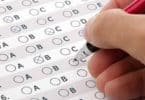International Finance Quiz:
Countertrade represents foreign trade:
(a) restrictions imposed by the government on imports from another country.
(b) restrictions imposed by the government on exports sent from the country.
(c) transactions that force the sales of goods of one country to be linked to the purchase or exchange of goods from the country.
(d) financing provided to an exporter in exchange for goods provided to the creditor by the exporter.
A(n) _____ is an unconditional promise drawn by one party, instructing the buyer to pay the face amount upon presentation.
(a) draft
(b) bill of lading
(c) trade acceptance
(d) letter of credit
Export promotion is an:
(a) Inward looking strategy
(b) Outward looking strategy
(c) Fiscal strategy
(d) Political strategy
Concerning a country’s business cycle, rapid growth of production and employment is commonly associated with:
(a) Large or growing trade deficits and current account deficits
(b) Large or growing trade deficits and current account surpluses
(c) Small or shrinking trade deficits and current account deficits
(d) Small or shrinking trade deficits and current account surpluses
Related: multiple choice quiz on Globalization
Reducing a current account surplus requires a country to:
(a) Increase the government’s deficit and increase private investment relative to saving
(b) Increase the government’s deficit and decrease private investment relative to saving
(c) Decrease the government’s deficit and increase private investment relative to saving
(d) Decrease the government’s deficit and decrease private investment relative to saving
All else equal and under a system of floating exchange rates, if a country enters a period of exceptionally strong growth,
(a) the pressure on its currency is to revalue.
(b) the pressure on its currency is to devalue.
(c) the pressure on its currency is to depreciate.
(d) the pressure on its currency is to appreciate.
(e) Both A and D.
Since March 1973, the world, more or less, had a:
(a) Free floating exchange rate system
(b) Fixed exchange rate system
(c) Managed floating exchange rate system
(d) Adjustable peg system
Consider an exporter that sells its accounts receivables off to another firm that becomes responsible for obtaining cash from the various importers. This reflects:
(a) accounts receivable financing.
(b) consignment.
(c) factoring.
(d) a letter of credit.
In balance of payments accounting, a credit entry for the home country is
(a) an international transaction in which foreigners make payments to residents of the home country
(b) one in which residents of the home country make payments to foreigners
(c) one which results from an import of goods into the home country
(d) one which results from an outflow of capital from the home country to a foreign country
Outward looking development policies are not associated with:
(a) Open system of communications
(b) Free movement of capital
(c) Multinational enterprises
(d) Learning by doing
Related: equity shares can be bought back mcq
The burden of a current account deficit would be the least if a nation uses what it borrows to finance:
(a) Unemployment compensation benefits
(b) Social Security benefits
(c) Expenditures on food and recreation
(d) Investment in plant and equipment
Consider an exporter that is willing to send goods to the importer without a guaranteed payment by the bank. The bank provides a loan to the exporter that is backed by the value of the exported goods. This reflects:.
(a) accounts receivable financing.
(b) for faulting.
(c) factoring.
(d) a letter of credit.
Import quota is :
(a) Tariff
(b) Non-tariff trade barrier
(c) Concession
(d) International obligation
Which of the following is not a payment method used for international trade?
(a) consignment.
(b) open account.
(c) factoring.
(d) draft.
(e) letter of credit.
On the balance-of-payments statements, merchandise imports are classified in the:
(a) Current account
(b) Capital account
(c) Unilateral transfer account
(d) Official settlement account
Related: microeconomics quiz questions and answers
Multinational firms face exposure to many different types of international risk. Which of the following is not a type of exposure?
(a) diversifiable risk
(b) political risk
(c) foreign economies
(d) exchange rate movements
The balance of payment in unfavorable:
(a) When value of export is greater than import
(b) When value of import is greater than export
(c) When value of imports and exports are equal
(d) Only when there is much greater difference between exports and imports
A ________ provides a summary of freight charges and conveys title to the merchandise.
(a) letter of credit
(b) banker’s acceptance
(c) bill of lading
(d) bill of exchange
The balance of international indebtedness is a record of a country’s international:
(a) Investment position over a period of time
(b) Investment position at a fixed point in time
(c) Trade position over a period of time
(d) Trade position at a fixed point in time
When a country realizes a deficit in its current account:
(a) Its net foreign investment position has become positive.
(b) It has become a net demander for funds from other countries.
(c) It realizes an excess of imports over exports of goods and services
(d) It becomes a net supplier of funds to other countries
With _______, the exporter ships the goods to the importer while still retaining actual title to the merchandise.
(a) a letter of credit arrangement
(b) an open account arrangement
(c) a draft arrangement
(d) a consignment arrangement
The balance of payment on current account shows:
(a) The record of the current position of the country in transfer of both visible and invisible items
(b) The record of the financial position of the country
(c) The extent of the financial position of the country
(d) The record of the current position of visible items
Which of the following exchange rate policies uses a target exchange rate, but allows the target to change?
(a) fixed exchange rate
(b) flexible exchange rate
(c) crawling peg
(d) moving target
Which of the following is not true regarding letters of credit?
(a) They are issued by banks on behalf of the importer promising to pay the exporter.
(b) A revocable letter of credit can be canceled or revoked at any time without prior notification to the beneficiary.
(c) They guarantee that the goods shipped are the goods purchased.
(d) All of the above are true.
Reducing a current account deficit requires a country to:
(a) Increase private saving relative to investment
(b) Increase private consumption relative to saving
(c) Increase private investment relative to consumption
(d) Increase private investment relative to saving
Related: macroeconomics test questions and answers
A firm that buys foreign exchange in order to take advantage of higher foreign interest rates is
(a) speculating.
(b) demonstrating purchasing power parity.
(c) engaging in interest rate arbitrage.
(d) responding to fluctuations in the business cycle.
(e) ignoring the nominal rate of exchange.
A bill of exchange requesting the bank to pay the face amount upon presentation of documents is:
(a) banker’s acceptance.
(b) time draft.
(c) letter of credit.
(d) sight draft.
A banker’s acceptance is a draft drawn on and accepted by a(n) _______.
(a) bank
(b) importer
(c) exporter
In order to protect against foreign exchange risk, firms can use
(a) the spot market for foreign exchange.
(b) interest rate arbitrage.
(c) purchasing power parity.
(d) the forward market for foreign exchange.
(e) the J-curve.
Reducing a current account deficit requires a country to:
(a) Increase the government’s deficit and increase private investment relative to saving
(b) Increase the government’s deficit and decrease private investment relative to saving
(c) Decrease the government’s deficit and increase private investment relative to saving
(d) Decrease the government’s deficit and decrease private investment relative to saving






